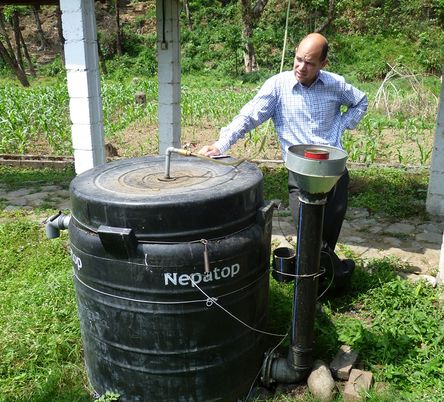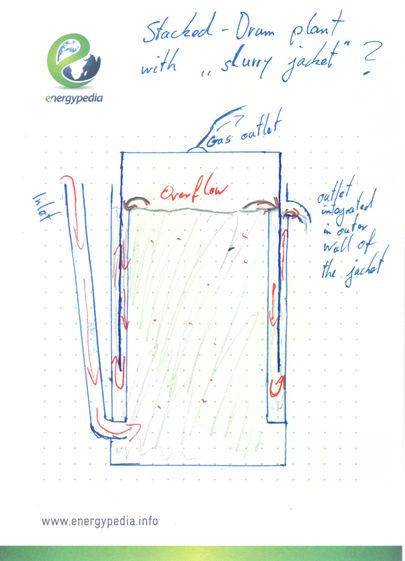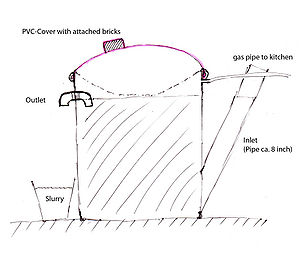Biogas Plant by ARTI
Original article from http://www.arti-india.org/index2.php?option=com_content&do_pdf=1&id=45
Biogas Plant by ARTI
ARTI (Appropriate Rural Technology Institute)has developed a compact biogas plant which uses waste food rather than dung/manure as feedstock, to supply biogas for cooking. The plant is sufficiently compact to be used by urban households, and about 2000 are currently in use – both in urban and rural households in Maharashtra. A few have been installed in other parts of India and even elsewhere in the world. The design and development of this simple, yet powerful technology for the people, has won ARTI the Ashden Award for Sustainable Energy 2006 in the Food Security category. This makes ARTI the only organization in the world to win the prestigious Ashden Award twice. ARTI won its first Ashden Award in 2002 for its chain of technologies for converting agricultural waste into charcoal, and using this as a clean domestic fuel.
The impending scarcity of petroleum threatens the world’s fuel supply. Mankind can face this threat successfully with the help of biogenous methane, but the world is yet to take full advantage of this technology, because its practitioners have so far ignore the basic tenet of science – viz. output of work is dependant on the energy available for doing that work. This fact is seen in the current practice of using low calorie inputs like cattle dung, distillery effluent, municipal solid waste or sewerage, in biogas plants, which makes methane generation highly inefficient. To rectify this skewed approach, in around 2003, Dr. Anand Karve (President of ARTI) developed a compact biogas system that uses starchy or sugary feedstock (waste grain flour, spoilt grain, overripe or misshapen fruit, nonedible seeds, fruits and rhizomes, green leaves, kitchen watse, leftover food, etc). Just 2 kg of such feedstock produces about 500 g of methane, and the reaction is completed with 24 hours. The conventional biogas systems, using cattle dung, sewerage, etc. use about 40 kg feedstock to produce the same quantity of methane, and require about 40 days to complete the reaction. Thus, from the point of view of conversion of feedstock into methane, the system developed by Dr. Anand Karve is 20 times as efficient as the conventional system, and from the point of view of reaction time, it is 40 times as efficient. Thus, overall, the new system is 800 times as efficient as the conventional biogas system.
Benefits
Most biogas plants which are currently in operation in India and elsewhere are designed for animal manure as their main feedstock, and are therefore used in rural areas. Whereas in cities, a majority of the people use LPG or kerosene for cooking. The immediate benefit from owning a compact biogas system is the savings in cost as compared to the use of kerosene or LPG for cooking. The up-front cost of a biogas system is higher than for LPG, since an LPG bottle plus a two burner stove costs only INR 5,000 (spprox. USD 100) whereas the compact biogas plan plus a biogas stove costs about INR 10,000 (approx. USD 200). However, the operational cost for biogas is only about INR 2 per day if waste flour is used as feedstock, and can be zero if the plant uses only food wastes. This is much cheaper than LPG, which costs about INR 30 per day, even with the current subsidy of 50%. Biogas can easily replace 50% of the LPG used by a family. Some families who use a pressure cooker for cooking and collect food waste from their neighbours have replaced all their LPG use.
Methane burns with a blue flame, without producing any smoke or soot. It is therefore an environmentally friendly cooking system. Thus, introduction of the new efficient, compact biogas system would not only help urban households in utilizing their domestic wet waste, but also help prevent millions of premature deaths of women and children in rural households due to indoor air pollution caused by smoke and soot from burning fuelwood in traditional chulhas. This markedly impacts the health of the people in the kitchen (mainly women) positively. Further reductions in pollution and energy use arise from not having to transport LPG cylinders to be re-filled. The small amount of solid residue produced by the biogas plant makes a good fertiliser.
On a global scale, it is well known that the replacement of fossil fuels reduces the emission of greenhouse gases. ARTI estimate that for a typical urban household, biogas saves 100 kg of LPG or 250 litres of kerosene per year, which is equivalent to 300 to 600 kg CO2 per year. A rural family could save about 3 tonnes of wood per year, which would generate about 5 tonnes CO2 if burnt.
Comparison with Conventional Biogas Plants
Biogas systems are those that take organic material (feedstock) into an air-tight tank, where bacteria break down the material and release biogas – a mixture of mainly methane with some carbon dioxide. The biogas can be burned as a fuel, for cooking or other purposes, and the solid residue can be used as organic compost.
The current practice of using low calorie inputs like cattle dung, distillery effluent, municipal solid waste, or sewerage, makes methane generation in conventional biogas plants highly inefficient. Through this compact system, it has been demonstrated that by using feedstock having high calorific and nutritive value to microbes, the efficiency of methane generation can be increased by several orders of magnitude. Operating the system on this simple tenet also brings in many more advantages over the conventional systems: As a result of the higher efficiency, the size and cost of the new system are also lower. While the conventional biogas system occupies about 4 cubic meters of space, the compact biogas system is about as large as a domestic refrigerator. It is an extremely user friendly system, because it requires daily only a couple of kg feedstock, and the disposal of daily just 5 litres of effluent slurry.
Conventional Biogas Systems ARTI Biogas system
Amount of required feedstock
40 kg + 40 lit water 1-1.5 kg + 15 lit water
Nature of required feedstock
Dung Any starchy material
Amount and Nature of slurry to be disposed of
80 lit, sludge 15 lit, watery
Reaction Time for full utilization of feedstock
40 days 48-72 hours
Standard size for household
4000 lit 1000-1500 lit
Establishing a New Trend: Biogas in Cities
In cities, waste food is often discarded and its rising heap attracts flies and rodents, thus creating a public health hazard. The compact biogas plant technology developed by ARTI readily accepts highly digestible organic materials such kitchen waste as feedstock and can easily blend into the urban lifestyle. A single plant produces sufficient biogas to at least halve the use of LPG or kerosene for cooking in a household, as well as a small amount of solid residue which can be used as fertiliser. ARTI’s compact biogas plant could be replicated anywhere where there is the space for the plant, and the temperature is sufficiently high.
This technology offers a solution not just for domestic waste disposal, but also for collective disposal of community waste. In villages, food waste was traditionally fed to animals or left by the side of the road for animals to devour. People continue to do this in cities but there are fewer animals to consume it. The result is that smelly, rotting food attracts flies and rats. Some authorities collect food waste and dispose of it in landfill. Here again, available land space presents its own constraints. For example: the authority in Pune has decided it can no longer dispose city waste in a landfill because of lack of space, and local officials are therefore strongly encouraging the use of biogas plants to dispose of food waste. Local council offices have set up demonstration plants, which use local food wastes and provide gas for making tea for local officials and their visitors.
What the Numbers Say
From 2003 onwards, about 1000 compact biogas plants have been so far installed by ARTI's trained personnel – covering both rural as well as urban households in Maharashtra. At least 1000 more plants have been installed by enthusiasts and hobbyists, using the instruction VCD widely produced and distributed by ARTI (click here for more information on our VCDs and booklets). In Maharashtra, several independent producers have copied the design for themselves. These existing plants are a useful advertisement for the advantages of biogas systems and consequently about 30-50 plants are now being installed per month.
In Maharashtra State alone, there are an estimated 500,000 potential users for this technology. ARTI aims to reach out to these potential users and more, with this revolutionary clean fuel technology. We also look to manufacture standardised feedstock in de-centralised units to facilitate ease in plant usage and set up sustainable entrepreneur chains for unit supply and maintenance.
Compact Biogas Plant - Details
The compact plants are made from cut-down high-density polythene (HDPE) water tanks, which are adapted using a heat gun and standard HDPE piping. The standard plant uses two tanks, with volumes of typically 0.75 m3 and 1 m3. The smaller tank is the gas holder and is inverted over the larger one which holds the mixture of decomposing feedstock and water (slurry).
An inlet is provided for adding feedstock, and an overflow for removing the digested residue. This contains a much smaller amount of solid matter than the residue from a manure-based plant, and ARTI recommend that the liquid is mixed with the feedstock and recycled into the plant.
A pipe takes the biogas to the kitchen, where it is used with a biogas stove. Such stoves are widely available in India which has a long tradition of using manure-based biogas plants.
The gas holder gradually rises as gas is produced, and sinks down again as the gas is used for cooking. Weights can be placed on the top of the gas holder to increase the gas pressure.
Installation
The plant is provided as a kit that takes only 2 to 3 hours to install. It needs a space about 2 m2 and 2.5 m high, although adaptations can be made if it is placed under a roof.
Starting the plant
The plant is filled with a starter mix, either cattle dung mixed with water and waste flour or else effluent from an existing biogas plant mixed with starch. The feeding of the plant is built up over a few weeks until it provides a steady supply of gas, typically 250 g of gas per day from 1 kg (dry matter) of feed.
What you can put into the plant
The feed can be waste flour, vegetable residues, waste food, fruit peelings and rotten fruit. Feedstock with large lumps (more than 20 mm) can be broken up with a food blender. Hand and pedal powered food blenders are being developed, for when electricity is not available. Oil cake, left over from oil-pressing, is another useful feedstock. Even rhizomes of banana, canna, nutgrass, non-edible seeds (e.g. Leucaena, Sesbania, tamarind, mango kernels) and spoilt grain serve as excellent feedstock material.
Precaution
A biogas plant can become acidic and fail if it is over-fed, and this is a particular challenge with a plant using highly digestible organic materials. If this happens, the plant can be recovered by ceasing feeding and then building up the feed rate slowly. This problem was more common with the early smaller systems (0.5 or 0.75 m3) than with the later, larger systems.
Video CDs giving step-by-step lucid explanation of on-site installation of this revolutionary technology is available in our offices to all for a nominal price of Rs. 100. For home delivery, anywhere in India, the price is Rs. 200 (inclusive of packaging and postage charges). Click here for ARTI’s contact details in this regard.
Source
http://www.arti-india.org/index2.php?option=com_content&do_pdf=1&id=45
Replications in Nepal and Bangladesh
|
Fibreglass stacked barrell plant in Bangladesh
|
|
Ideas for Improving the Model
Some difficulties are reported regarding loss of gas or blocking of the outlet by the floating drum.
I had a little idea that might work and added a quick drawing on this, please comment and add your own ideas and drawings. I like to call these compact models "stacked drum plants".
Stacked-drum Plant with "slurry jacket"
The idea is derived from the document about ARTI Plants in India. There they applied a water jacket but had to work around a couple of things to get the outlet of the plant into the digester. I thought, maybe the jacket could be part of the outlet.
the way of the feedstock is marked in red:
- It goes into the digester as usual. The feedstock in the upper part is usually low in particles and consits mostly of slurry that is already digested.
- When feeding the plant the slurry flows over the inner walls of the jacket and fills it.
- The outlet is integrated into the outer wall of the jacket.
- the gas loss should be minimized and close to 0.
- Less piping is needed, which also minimizes the risk of something going wrong with pipes inside the digester.
- I am not sure if sedimenting particles might block the movement of the digester after a while, but maybe the overflow will be enough to flush sediments out there.
Actual example of small stacked drum plan with water jacket: http://kottayam.olx.in/install-biotech-portable-biogas-plants-and-convert-food-waste-to-biogas-iid-320528866
One Drum Biogas Plant with Flexible PVC-Cover
The proposed biogas plant is adapted from the current ARTI-Model (as describes above),
yet it is not tested (April 2011).
Instead of the two drums, only one drum is used (1000 litres) and a cover from flexible PVC-Cover (that is the same material used to cover lorries, can be glued with special PVC-glue). Some Details:
- The inlet is a normal pipe from the market (about 8 inch in diameter), attached to the drum in a step angular. The use of one direct pipe (instead of an angle at the bottom) has the following advantage: in case of a blockage of the inlet, one may push with a stick the feeding material deeper into to drum.
- The outlet of the slurry consists of normal plastic-pipes from the market (diameter 3-4 inch).
- The PVC-Cover is the most tricky one: One has to glue the several parts together in order to receive a half-rounded cover (the details about cutting and glueing will follow) and inlets for the bricks (as some pressure of the gas is needed for the transport into the kitchen. The PVC-Cover will be attached to the Drum with the help of air pressure: A half-cutted Plastic-Pipe (about 3 inch) is lead around the drum as a ring. Inside the ring is a tube from a bicycle with an outside valve. For a tight attachment, one has only to pump up the bicycle tube, which presses the PVC-Cover against the wall of the drum.
- The estimated Costs are as follows (Nepal, April 2011):
Drum 1000 Litres EUR 90
Inletpipe (8 inch) EUR 10
Bricks EUR 5
Valve and multilayer-pipe to kitchen EUR 15
Outlet pipe (3-4 inch) EUR 5
PVC-Cover EUR 15
Half-cutted pipe EUR 3
Bicycle tubes EUR 6
Grand Sum EUR 149
Further Reading
- APPROPRIATE RURAL TECHNOLOGY INSTITUTE
- How to build an ARTI biogas plant;www.howtopedia.org
- How to run an ARTI plant (youtube video)
- ARTI Biogas in India (EAWAG, pdf, 1.6MB )
- ARTI Biogas in Tanzania (EAWAG, pdf, 2MB)
- http://en.howtopedia.org/wiki/How_to_Build_the_ARTI_Compact_Biogas_Digestor
Biotech-India Brochures
- Biogas plants.pdf Specific Brochure
- Portable Plants.pdf Specific Brochure
- kitchen to kitchen Domestic Bio Waste treatment plants.pdf Specific Brochure
Other Urban Biogas Ideas
























